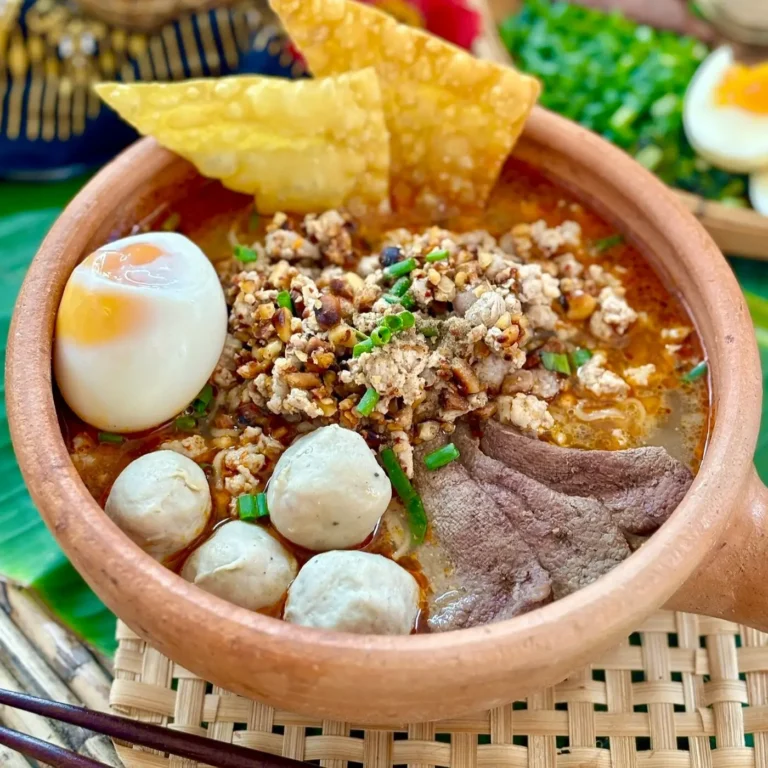Khao Piak Sen Recipe (Lao Noodle Soup)
As an Amazon Associate, I earn from qualifying purchases. Read the full disclosure here .
This authentic khao piak sen recipe shows you how to make a comforting Lao noodle soup with pork or chicken. I also show you how to make homemade tapioca noodles, with photo instructions and plenty of topping ideas!

Khao piak sen is a thick Lao noodle soup made with chewy tapioca noodles and a peppery chicken or pork broth. It’s often topped with crispy garlic, green onions, and lime, and usually eaten for breakfast or lunch.
About this Lao soup
This recipe starts by pounding fresh aromatics into a rough paste to build flavor right from the beginning. The paste is fried in oil before adding pork ribs and water, creating a deep, rich broth that simmers low and slow.
While the soup cooks, we’ll make the tapioca noodles from scratch. If you’re short on time, you can also grab ready-made khao piak sen noodles (or udon noodles as a substitute) at most Asian grocery stores.
Once the broth is done, just boil the noodles briefly in the soup, ladle into bowls, and finish with your favorite toppings. I’ll share my go-tos down below.

Quick note: Although this is a Thai food blog, you’ll find plenty of Lao recipes here too. Thai and Lao cuisine are closely connected, especially in northeastern Thailand near the Laos border.
You’ll often see soups like khao piak sen and khao poon (Lao chicken noodle soup) on Thai menus, especially when the chef has Lao or Isan roots.
I was born in Mukdahan, which is right next to Laos. Soups like this are on my weekly dinner rotation, especially when the weather cools down or when I just want some comfort food!
Ingredient notes and substitutes
I’ve included ingredient tips and step-by-step photos below, or you can jump straight to the recipe card if you’re ready to start cooking.
For the tapioca noodles
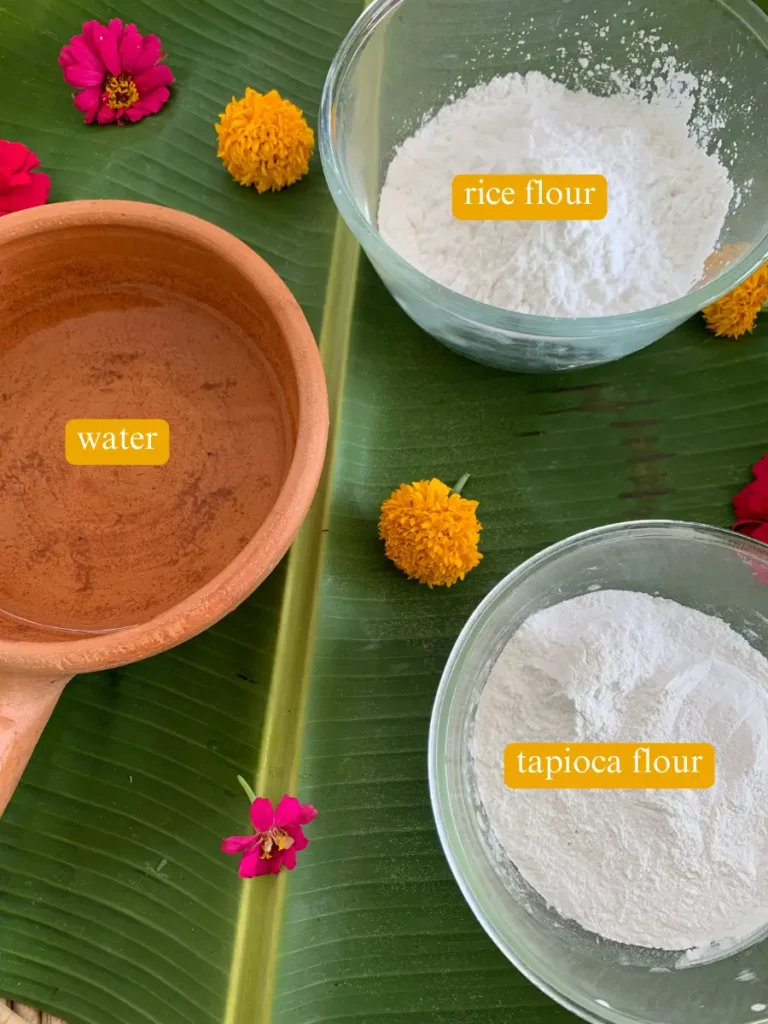
- Tapioca flour (tapioca starch)
- Rice flour
- Hot water
For the broth

- Pork spare ribs
- Pork meat
- Golden mountain sauce – Golden mountain sauce is a Thai seasoning sauce with a savory and umami-rich flavor. Get it on Amazon.
- Black peppercorns
- Light soy sauce
- Coriander root
- Garlic
- Onion
- Salt
- Water
- Oil – Use a neutral cooking oil like canola oil or sesame oil.
- Moo joh (optional) – A Thai-style sausage with a rich, savory flavor. You can sometimes find it at Asian grocery stores.
Optional toppings and garnish
- White or black pepper
- Kaffir lime leaves
- Pepper flakes
- Green onions
- Fried shallots
- Fried garlic
- Cilantro
- Chili oil
- Lime
How to make khao piak sen
1. Make the broth
Step 1: Start by pounding garlic, black peppercorns, and coriander root into a coarse paste using a mortar and pestle or food processor.
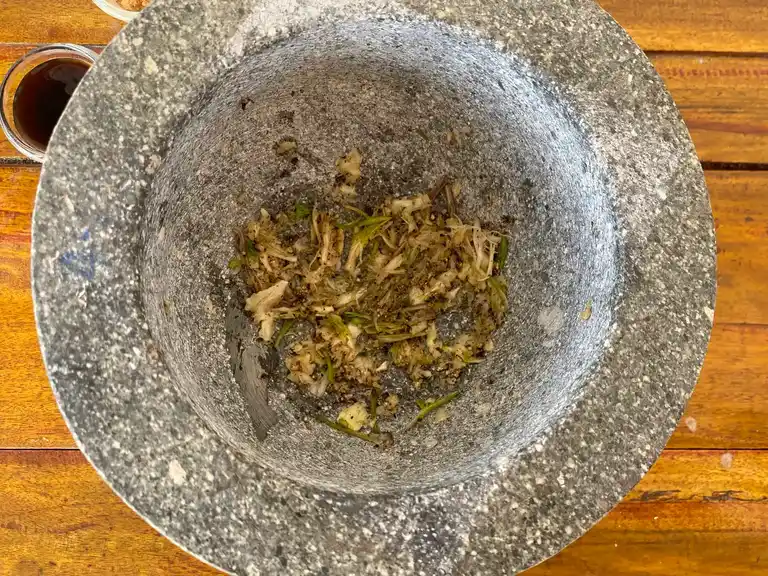
Step 2: Heat oil in a large pot over medium-high heat, then add the paste and sauté until fragrant.
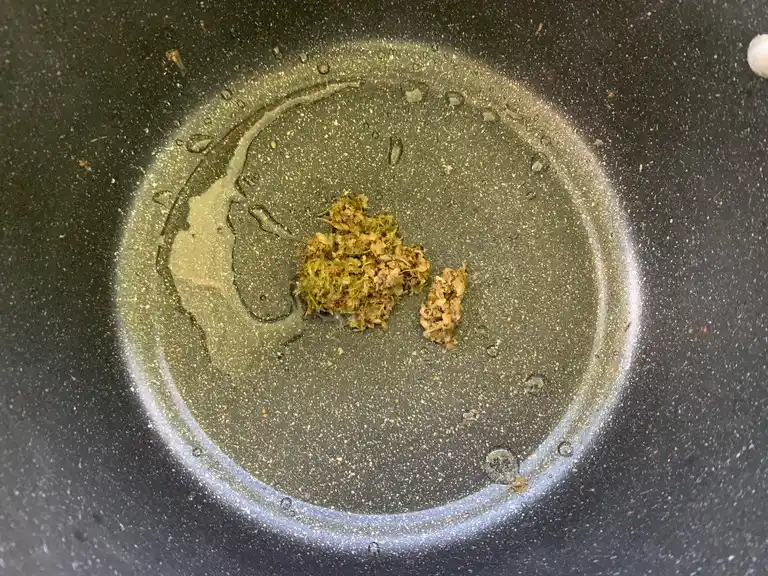
Step 3: Add the pork ribs and sear them until they’re no longer red on the outside.

Step 4: Pour in water to prevent the aromatics from burning, then bring everything to a gentle simmer.
Step 5: As the broth boils, skim off any foam that rises to the top to keep the soup clear and clean-tasting.
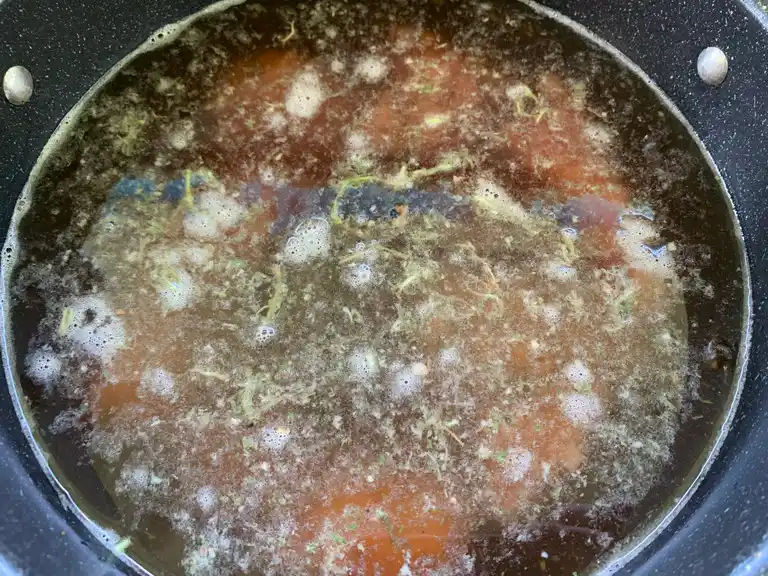
Step 6: Add sliced onions, soy sauce, golden mountain sauce, and salt.
Step 7: Once the soup comes back to a boil, reduce the heat, cover the pot, and let it simmer for about 40 minutes, so the flavors can deepen. You can now get started on the noodles if you’re making them yourself.
Step 8: In the final few minutes, add pork meat and sliced moo joh sausage (if using). Let everything cook through. While it simmers, you can get started on the noodles.
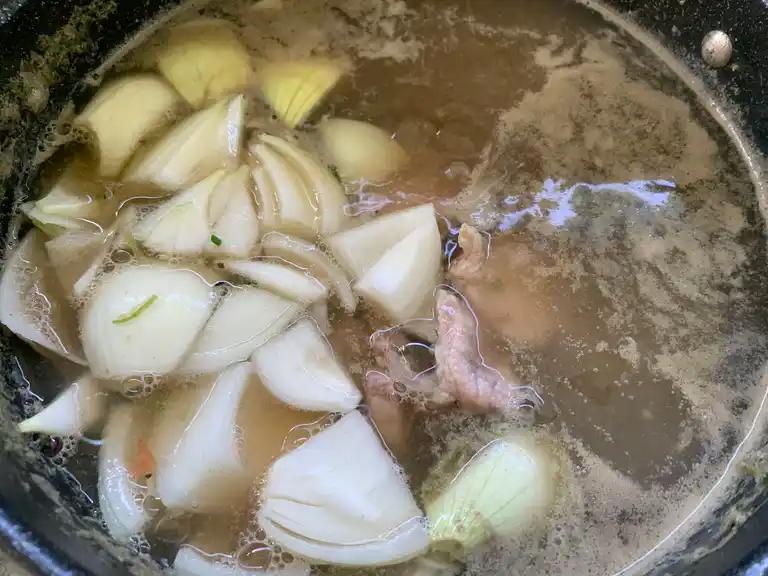
2. Make the noodles
Step 1: Pour tapioca flour into a mixing bowl and make a small well in the center. Slowly add boiling water and stir quickly with a spoon or dough hook. The dough will start turning slightly translucent.
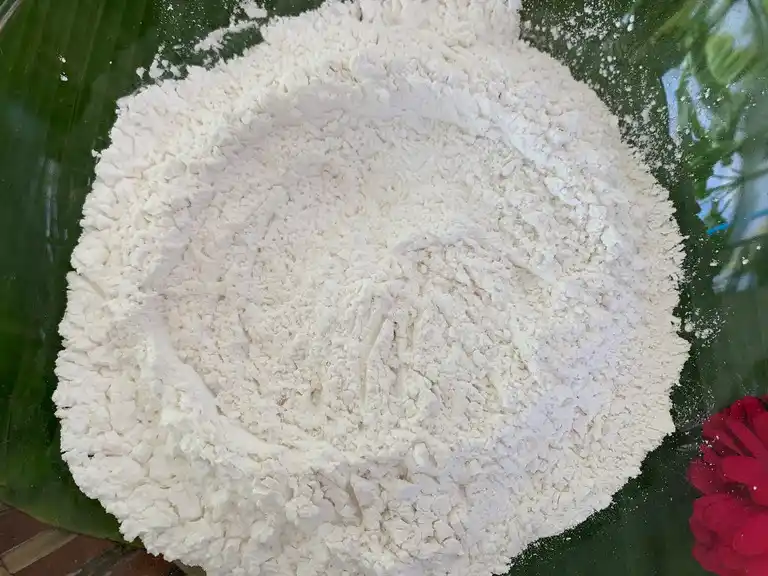
Step 2: Add rice flour and knead until the dough is smooth and not sticky. If it’s too dry, add a bit more warm water.

Step 3: Transfer the dough to a lightly floured surface. Shape it into a thick log using a sharp knife, and divide it into three sections.

Step 4: Dust your rolling pin with tapioca flour and roll one section at a time to your desired thickness.
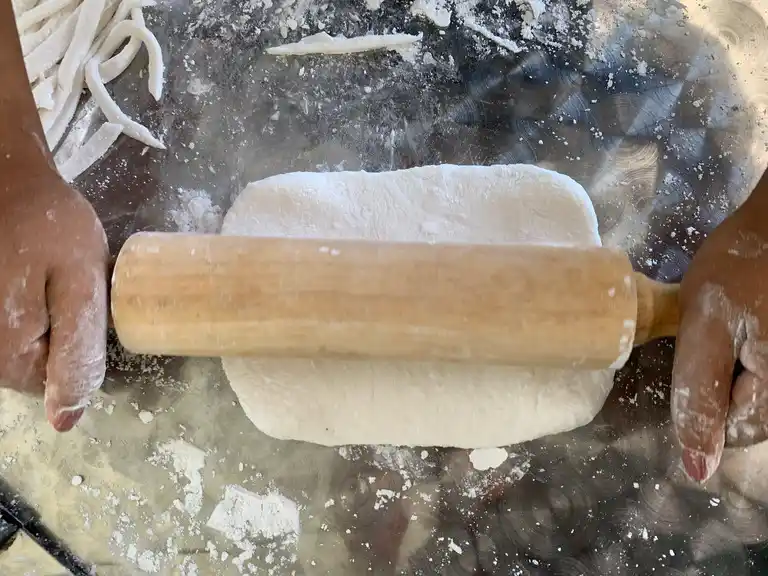
Step 5: Slice into noodles about ¼ inch wide. Don’t worry about making them perfect, these are meant to be rustic and chewy.
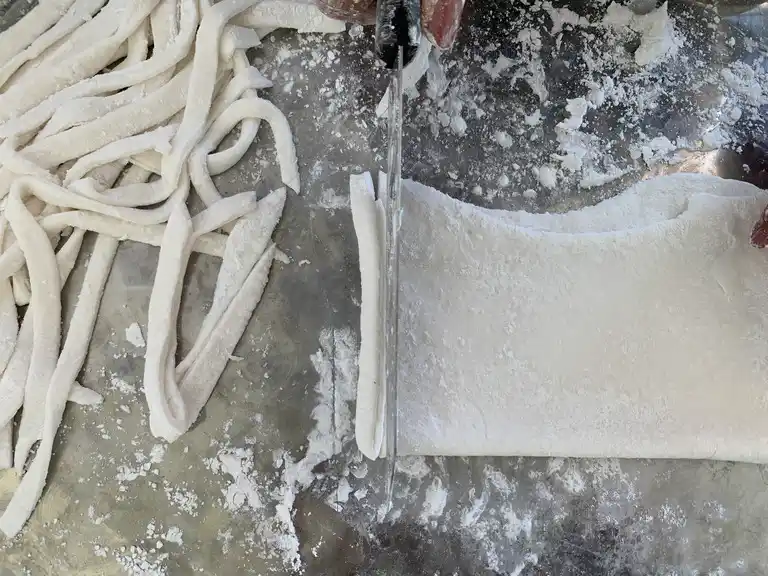
Step 6: Place the cut noodles on a floured tray and sprinkle a little more tapioca flour over the top to keep them from sticking.
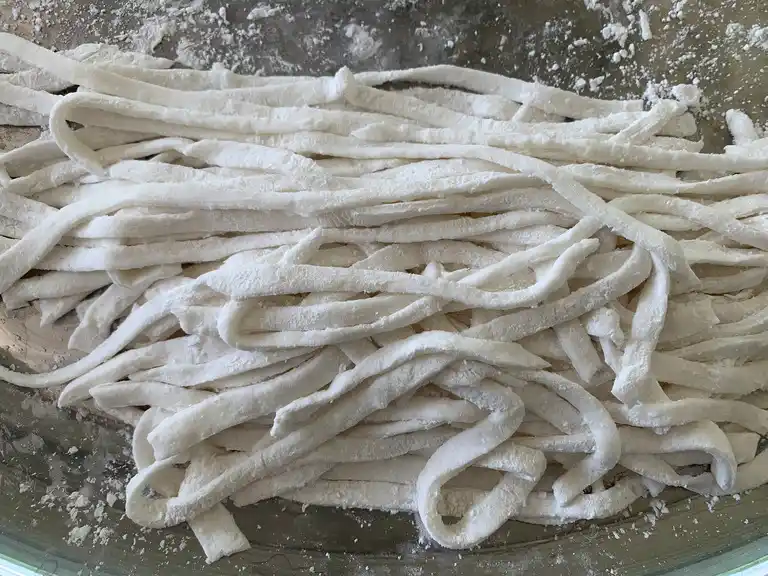
3. Cook and serve
Step 1: Once your soup is ready, boil the noodles in the broth for 2 to 3 minutes until they float and turn slightly glossy.
Step 2: Ladle into a serving dish, making sure each one gets a good mix of noodles, meat, and some bone if using ribs. Add toppings to your finished bowl of soup with noodles, like fried garlic, fried shallots, fish sauce, lime, and fresh herbs such as cilantro and green onions.
Storage tips
- Storing: Keep the broth in an airtight container in the fridge. Store the noodles separately in a ziplock bag to prevent them from getting too soft.
- Freezing: Freeze the broth for up to 3 months. You can freeze the noodles too, but they may lose some of their chewiness.
- Reheating: Warm the broth on the stove over low heat. Add the noodles straight in, or dip them briefly in boiling water to freshen them up before serving.
Frequently asked questions
Can I make this vegetarian?
Yes. You’ll miss out on the flavor from the pork bones, but you can still make a tasty version by adding your favorite soup vegetables like carrots, daikon, or mushrooms instead.
Is the recipe gluten-free?
The recipe is not gluten-free unless you use gluten-free soy sauce and skip golden mountain sauce or replace it with a gluten-free alternative. The noodles themselves are gluten-free.
More noodle soups you’ll love
Use this khao piak sen recipe to make Lao noodle soup at home! Let me know how it turns out in the comments below. Follow me on social media: Facebook, Instagram, and Pinterest.
Khao Piak Sen Recipe (Lao Noodle Soup)

Equipment
- Cutting board and sharp knife
- Large soup pot
- Mixing bowl for preparing the tapioca noodle dough
- Rolling Pin to roll out the noodle dough
- Baking sheet to hold the noodles
Ingredients
For the noodles
- 1 cup rice flour
- 1 cup tapioca flour
- 1 cup boiling water
For the soup broth
- 1 tablespoon oil
- 3 cloves of garlic, peeled
- 3 coriander root
- 1 teaspoon black peppercorns
- 1 onion
- 1 lb pork ribs
- 70 fl oz or 9 cups water
- 1 onion
- 2 tablespoons light soy sauce
- 2 tablespoons golden mountain sauce
- 1 tablespoon salt
- 7 oz or 1 cup pork, thin slices
- 10 oz moo joh sausage, optional, thin slices
Optional toppings
- red pepper flakes, garnish to taste
- fried shallots, garnish to taste
- fried garlic, garnish to taste
- green onions, garnish to taste
- coriander, garnish to taste
Instructions
Make the broth
- Pound garlic, black peppercorns, and coriander root into a coarse paste using a mortar and pestle or food processor.
- Heat oil in a large pot over medium-high heat and fry the paste until fragrant.
- Add pork ribs and sear until no longer red.
- Pour in water and bring to a simmer.
- Skim off any foam that rises to the surface.
- Add onions, soy sauce, golden mountain sauce, and salt.
- Bring to a boil, then reduce heat, cover, and simmer for 40 minutes.
- Add sliced pork and moo joh sausage if using. Simmer for another 5 minutes.
Make the noodles
- Pour tapioca flour into a bowl and make a well in the center. Slowly add boiling water while stirring.
- Once it turns slightly translucent, mix in the rice flour. Knead until smooth and non-sticky.
- Shape the dough into a log and cut into three pieces.
- Roll out one piece to your desired thickness using a rolling pin.
- Slice into noodles about one-fourth inch wide.
- Dust with more tapioca flour to keep the noodles from sticking.
- Boil noodles in the soup for two to three minutes until cooked through.
To serve
- Ladle soup and noodles into bowls. Add your favorite toppings like fried garlic, shallots, lime, scallions, coriander, or chili flakes.
Notes
- Use the nutrition card in this recipe as a guideline.
- Feel free to add vegetables like mushrooms, morning glory, celery, or bean sprouts. Anything you’d normally toss into a soup works great here.
The tapioca noodles are naturally gluten-free.



